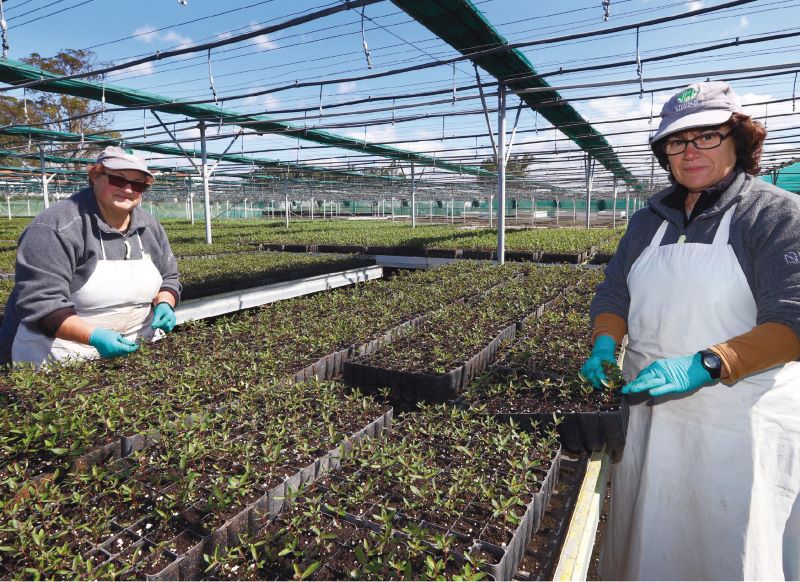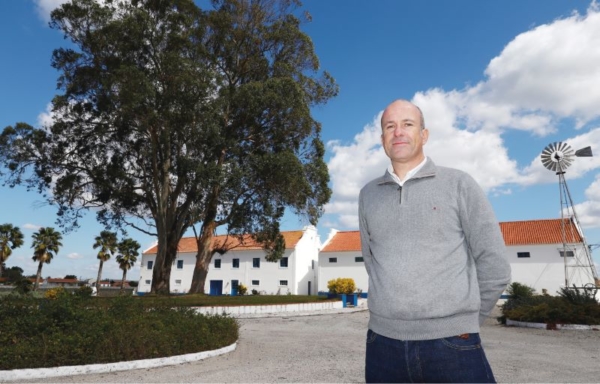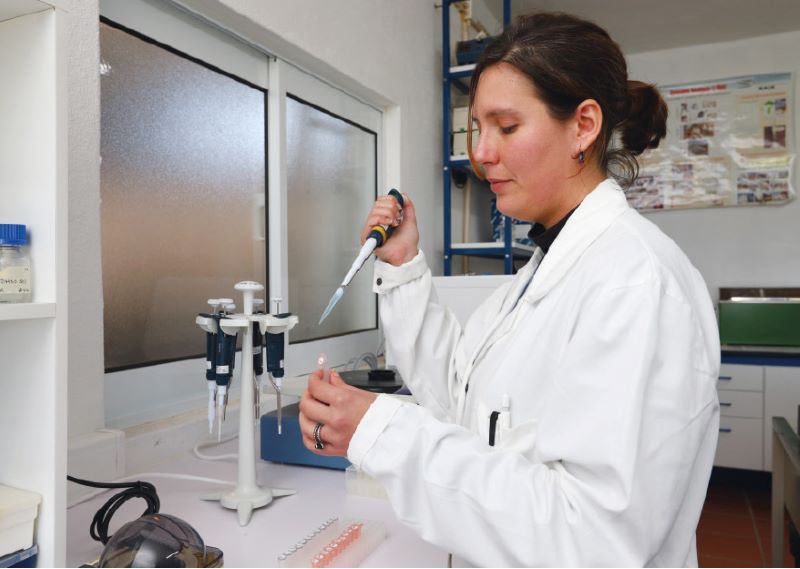Just over half an hour’s drive south of Lisbon, into the hinterland of Montijo, we pass Santo Isidro de Pegões and then take the turning to the nurseries, in the municipality of Palmela. Before we reach the single-storey office buildings on the Espirra estate, our first welcome is from the peacocks, blue necks shimmering in the sun and tails in their full glory.
In addition to the nurseries, the estate also features extensive areas of cork oaks, umbrella pines, eucalyptus and poplars. And vineyards, producing wines that make a nod to our feathered hosts: Pavão (= Peacock) de Espirra Tinto and Pavão de Espirra Rosé.
“With the nurseries, the vineyards and the woodlands, there’s someone with their hands in the earth all year round”, we heard from Miguel Ferrinho, the manager of Viveiros Aliança, the company managing The Navigator Company’s trio of nursery facilities.
In addition to Espirra, which is the largest (20 hectares), there are also nurseries in Caniceira (11 ha), near Abrantes, and in Ferreiras (2.5 ha), in Penamacor. Combined, they produce around 10 million plants a year, not just for the Company’s own forestation programme, but also for external sales, ranging from eucalyptus clones to ornamental plants and shrubs.
The process

Between May and August the nurseries get down to the task of producing the clones which will be planted out in the autumn and the following spring.
Clones are propagated by means of cuttings, a process in which plants are produced by taking cuttings from a mother plant. In 2018 In 2018, an investment was made to increase production from 6 million clonal plants to 8.6 million.
In order to achieve this, one initiative has been to work with mini-cuttings, a production method widely used in Brazil for tropical eucalyptus, using smaller herbaceous cuttings than in the macro-cutting procedures used at Espirra.
So one of the greenhouses is not home to an experimental mini-cloning facility set up by RAIZ (Navigator’s forestry and paper research institute), with mini-eucalyptus trees, which look just like bonsai trees. “These mother plants are constantly being pruned, and the shoots will make cuttings for producing clones; we plan to produce 600 thousand plans from mini-cuttings,” the manager explained to us.
Two teams of Employees are at work, pruning shears in hand. Working around the concrete tubs, they prune the mother plants, preparing them for the next production season, which starts in May.
The open-air section is home to 70 thousand mother plants, for different clones, in hundreds of concrete pipe sections used as tubs; beyond these, a similar number are planted in the ground.
“During the season, each of these mother plants will produce an average of 80 to 90 cuttings; some of them have new shoots after just ten days”, explained Maria Pêgas, a supervisor who has been tending these plants for twenty years. When the time comes, “the cuttings are taken and much of the leaf surface is removed, and the resulting cutting is planted in a tube with substrate; this grows into the cloned plant”, Miguel Ferrinho told us.
“When you can see the red bud peeking out, you know it’s taken”, said Maria Pêgas. “It’s like taking care of kids, we have to talk to them, or else…”, she tells us cheerfully. The “red bud” is the first sign that new leaves will grow from the cutting.
The cutting starts its life in the biofactory and then moves on to the shade houses, which act as incubators and where the small eucalyptus plants are carefully protected: “There are strict rules for maintaining a tightly controlled microclimate, with a high level of humidity; this is the most critical stage for the plant to survive.”
The next stage, which lasts 25 to 30 days, consists of rooting. After this, they are placed outdoors (hardening phase), “when they are exposed to the elements to harden them off, before they are planted,” explained Miguel Ferrinho.
In the three shade houses for cloned plants and in the biofactory, constant care is taken in tending and sorting the plants; weeds have to be removed, as they steal energy, and the clones have to be fertilised.
The nurseries also produce two million eucalyptus trees from seed, some of them normal (selected) and others improved. In the first case, “seeds are gathered in eucalyptus plantations, when the trees are felled, and later sown in trays.
There is always a degree of uncertainty, as the mother plant is known, but not the father. There improved seeds, on the other hand, come from a seed orchard occupying a hectare, here on the estate, where the best clones are planted (27 different clones) in order to cross-pollinate, in an areas well away from other eucalyptus stands, to avoid contamination from other pollen.
We know that, in principle, they will produce a good eucalyptus plant; RAIZ’s research points to growth 15 to 20% superior to that of normal seeded plants,” the Viveiros Aliança manager told us.
Starting small
Plants only leave the nurseries after being certified. The process starts when still a seed, which has to be registered with the Institute of Nature Conservation and Forests, which is the external certification authority. Of the four certification levels awarded, the seeds from the eucalyptus orchard on this estate are included in the top category: “Our orchard is the only one in Portugal in the tested category”, Viveiros Aliança’s manager told us.

“As investment in forests is long term, you need a high quality of plants, to ensure growth over many years” – Miguel Ferrinho
“The nurseries are the start of the production chain, the maternity ward. The eucalyptus trees that leave here have had a good start, but like children they then need a good education as they grow, good nutrition, in order to become successful adults,” he concluded. This is how a forest is made, starting small.
Cloning

As well as the Viveiros Aliança nurseries, the Espirra estate is also home to a research centre operated by RAIZ, Navigator’s forestry and paper research institute, which conducts research into cloning, in close collaboration with the nurseries.
“The nurseries produce plants from six clones which have proved to offer good performance. We work with hundreds, looking for the best, with good properties in terms of rooting, wood, growth…. In the end we select only the best and propose them to the nursery – they are the result of years and years of work,” explained Joana Costa, a researcher in the field of biotechnology and plant propagation.
A farming technique known to man for millennia, cloning means no more than propagating plants from cuttings: “we cut a shoot from a tree, and use a section of the shoot and put it in a tube with substrate, we water it, and we know that the tree that grows from this will be the same as the original tree, as there is no genetic mix,” explained Miguel Ferrinho.
In other words, the parent plant and the clone are genetically identical. Because no individuals are crossed, as in production from seeds, the production of cloned plants from cuttings is known as vegetative propagation.
For many years, the woodlands operated by Navigator’s precursor’s had mass selection programmes in the field: “The teams would go into the field to identify the best shaped trees, presenting the best and most vigorous growth, and cut off shoots, which were then taken to the laboratory and replicated through cutting, producing plants identical to that gathered in the field, and the clones were then planted out in trial plantations to assess their potential”.
Producing plants from seeds is a different matter: “When there are seeds, there is a mother and a father, there is a genetic recombination, resulting always in a group of individuals genetically different from each other,” explained Miguel Ferrinho.
RAIZ’ work also involves crossing first generation clones from plant gathered in the field, in mass selection. “When we cross them, there is a genetic recombination, the genes from the father trees recombine with those from the mother trees, and this results in distinct individuals.” These are planted out in the field, to see if they “are more productive than the previous generation.”
José Araújo, in charge of the team developing cloned materials, explained that the aim is always the same: “To gradually increase the average value of the plants produced by Viveiros Aliança”.